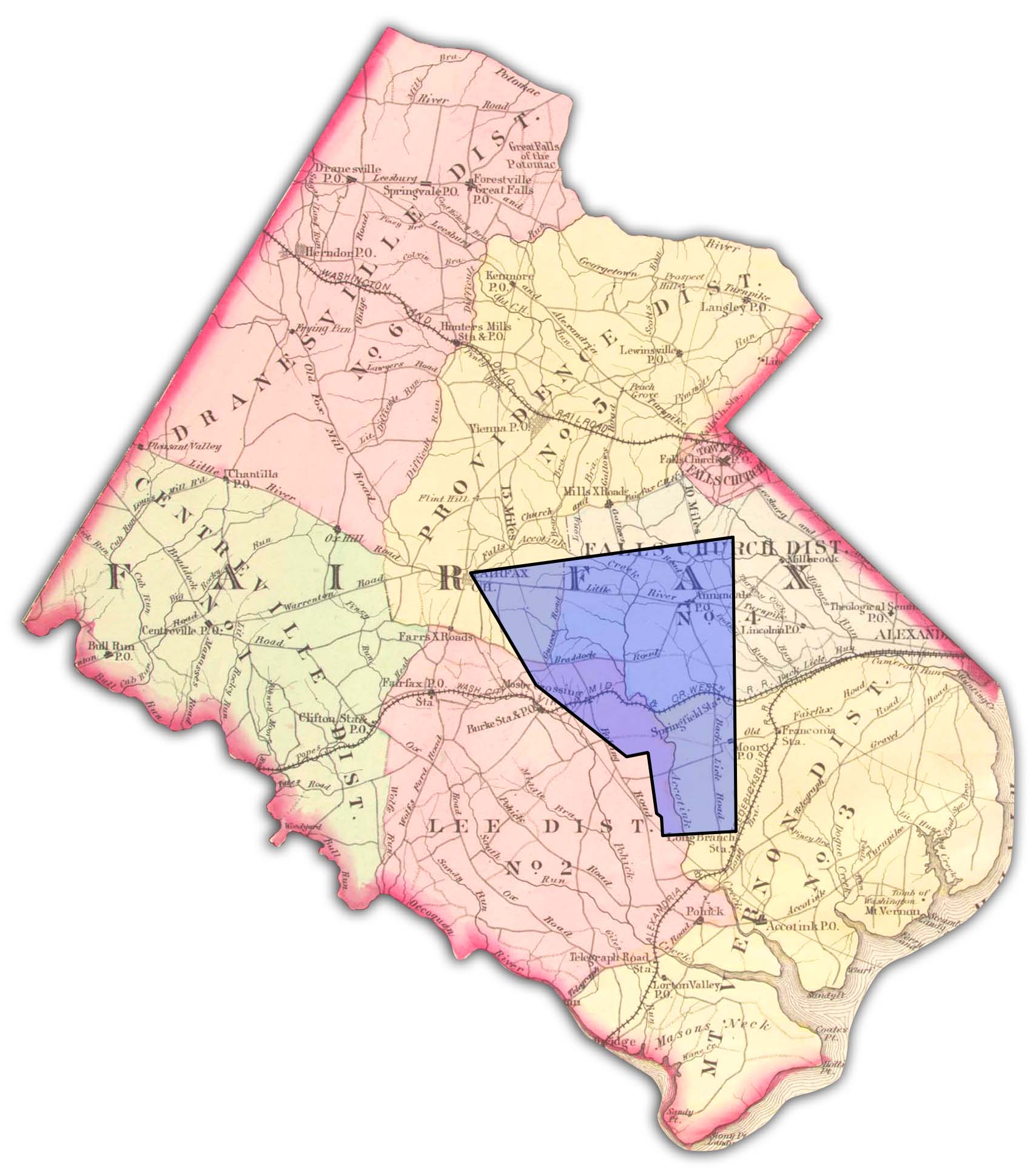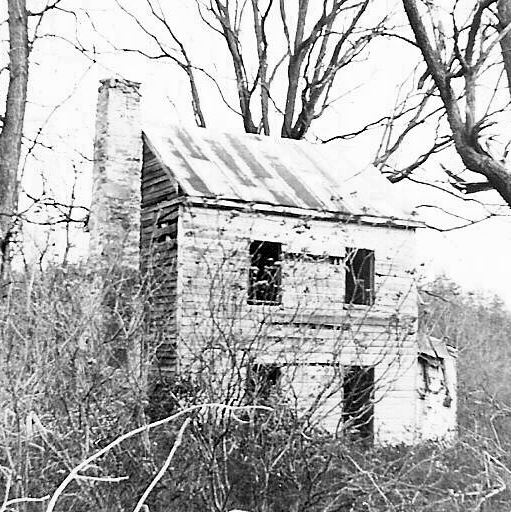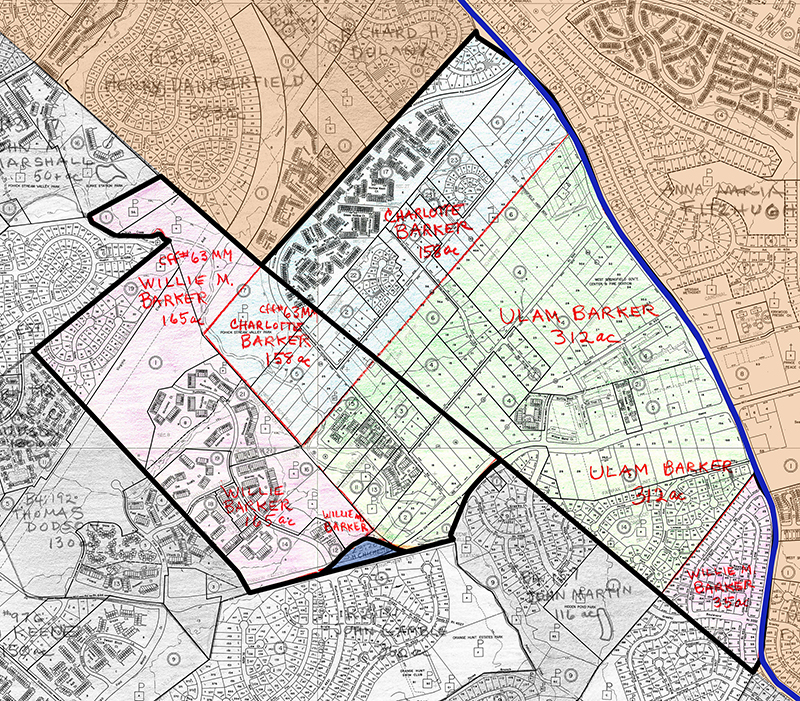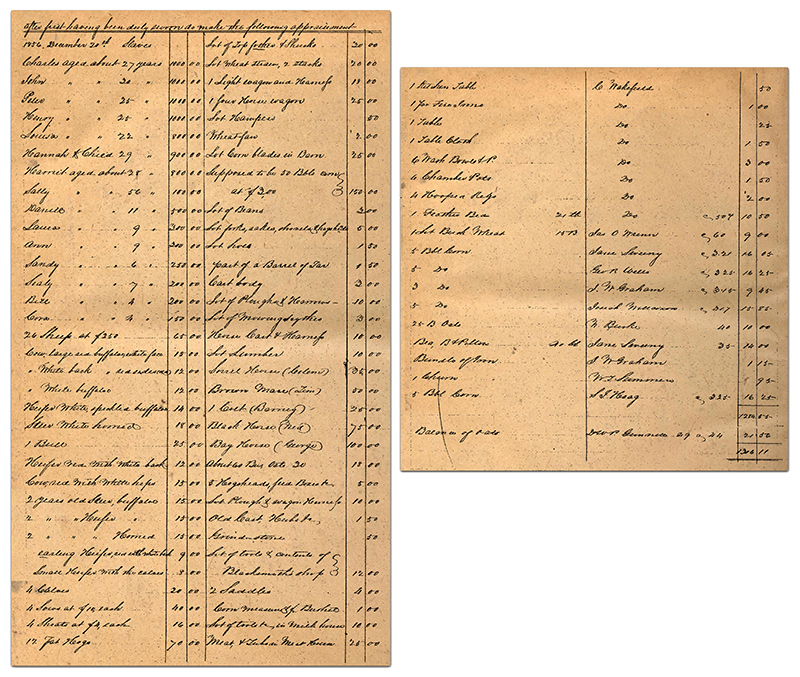Local History: The Barker Family
Farmers, Millers, and Slaveholders
Well before the creation of housing subdivisions and shopping centers, the West Springfield area, and in particular the property where West Springfield High School stands today, was owned by the Barker family. In 1741, William Barker was granted 287 acres of land along Pohick Run by Thomas, the 6th Lord Fairfax. In 1793, William sold a portion of this land to his grandson Presley Barker. Presley Barker acquired additional property in the 1830s, including the present day site of West Springfield High School. This land was formerly part of Ravensworth, a large plantation owned by the Fitzhugh family.

A Home in Hidden Pond
Did you know that the Barker family home and cemetery were once located in the vicinity of Hidden Pond Nature Center? This photograph of the house is believed to have been taken around the year 1960.

The Estate of Presley Barker
In 1856, Presley Barker passed away leaving behind a widow and two children, and his estate was divided among his heirs.

The West Springfield High School site passed to his widow Charlotte, then to their son Ulam, who further divided and sold his inheritance during the 1860s and 1880s.

Presley Barker’s Last Will and Testament and an inventory of his estate were recorded at the Fairfax County Circuit Court. These documents offer a fascinating glimpse into life on the Barker family’s farm. The first notations on the inventory are slaves. Barker held 16 enslaved individuals; 7 of whom were male, and 9 female. The oldest was Sally, age 56, and the youngest was an unnamed newborn infant of Hannah, age 29. Half of the slaves were children under the age of 12. A monetary value was assigned to each person, and four men: Charles, John, Peter and Henry were assigned a value of $1,000 each. Sally was assigned a value of $100. From the inventory we also learn that the Barkers raised livestock (horses, cows, geese, and pigs), and farmed corn, wheat and oats.
West Springfield High School Land Ownership
This chain of land title research was conducted by West Springfield Applied History students Christina Turner and Omar Abdel, Class of 2016.
1741: Land Grant to William Barker
- On October 26, 1741, Thomas the 6th Lord Fairfax, Baron of Cameron, Proprietor of the Northern Neck of Virginia, grants to William Barker (Sr.), 287 acres of land in Prince William County (later part of Fairfax County) on the north east side of the North Main Branch of Pohick adjoining the land of Fitzhugh, Melton, etc. (Northern Neck of Virginia Land Grants, Library of Virginia)
1793: William Barker to William Barker, Jr.
- On April 15, 1793, William Barker and Mary his wife to William Barker, Jr. of the 2nd part and Presley Barker, son of the said William Barker, Jr. of the 3rd part; for 33 pounds sterling, William Barker, Sr. sells to Presley Barker 100 acres of land in Fairfax County along Grafton Kirk's cool spring branch where it empties into Pohick Run, then up the run to the said William Barker then along an run, then along his line to Ravensworth. This was part of a larger tract of 287 acres of land granted to William Barker by the Proprietor's Office. (Fairfax County Deed Book Y-1:111)
1797: William Barker, Sr. to Leonard Barker
- On July 31, 1797, William Barker transfers to his son Leonard the land granted to William from the Proprietor's Office on Oct. 26, 1741; described as 187 acres of land in the line of Ravensworth and Pohick Run, then to the line dividing the part granted to Presley Barker, grandson to the said William Barker by deed on April 15, 1793. (FXDB A-2:101)
1800: The Last Will and Testament of William Barker (Sr.)
- The will of William Barker (Sr.) was written on March 9, 1795 and proved in court on January 21, 1800. He devises land and slaves to several heirs: To son Leonard Barker the land where he now lives bounded by the land of William Barker, Jr. and my spring branch. To daughters Barbary Barker and Nancy Barker the use of the land where William lives while they are single, then it passes to son Leonard Barker. A slave named Fairfax is devised to Aaron Barker and his heirs. He also names grandchildren John Harrison Barker and Nancy Barker. They were the children of William's daughter Nancy Barker who married Josiah Barker. He also devises to son William Barker, Jr., daughter Sarah Gray, daughter Mary Smithiman, daughter Anna Devers, daughter Elizabeth, deceased, to her unnamed heirs, son Moses Barker, deceased, to his unnamed heirs, and to son John Barker, deceased, to his unnamed heirs. (Will Book H-1:83)
1819: The Last Will and Testament of William Barker (Jr.)
- The will of William Barker, Jr. was written on March 3, 1818, and was proved in court on Oct. 18, 1819. He devised to wife Eleanor Barker the four slaves Jacob, Moses, Patience and Susan. He also named heirs: daughter Cynthia Gray, who was living in South Carolina; daughter Violett Simpson, wife of William Simpson; daughter Elizabeth Simpson, wife of Thomas Simpson; son Presley Barker, to whom he devised a slave named Ann after his mother's death; son Dennis Barker, to whom he devised a slave named Moses after his mother's death; and daughter Unice Barker, to whom he devised the slaves Jacob and Patience after her mother's death; son William Barker; daughter Eleanor Barker, wife of John Harrison Barker; and grandson Presley Barker, son of Eleanor, to whom he devises a slave named Susan after his wife's death. (FXWB L-1:374)
1820: Land Sale to Presley Barker
- On October 1, 1820, William Henry Fitzhugh and Anna Maria his wife of Ravensworth, Fairfax County, sell to Presley Barker of the town of Alexandria, Washington, D.C.; for $4,100; 410 acres, a part of the Ravensworth tract, bounded by Rolling Road and the lands of Presley Barker and others. (FXDB S-2:293)
1838: Land sale to Presley Barker
- On March 19, 1838, Silas Burke, trustee, of Fairfax County, sells to Presley Barker of same; for $1,654; 174.5 acres of land on Pohick Run along the line of James Burke, deceased, to a corner with James Keene's heirs and William Keene, then along a road (Old Keene Mill Road) and the south side of Pohick Run. (FXDB D-3:509)
1838: Land sale from Presley Barker to Sutherland
- On March 15, 1836 Presley Barker and one Archibald Hall, now deceased, purchased land from Silas Burke, administrator of the estate of James Keene, deceased, among which was a grist mill and a saw mill (the Keene Mill of Old Keen Mill Road on Pohick Run), and 4 acres of land. Presley Barker and Bernard Hooe convey the mills and the 4 acres to William and John Sutherland on March 20, 1838. (FXDB D-3:539)
1838: Division of the Estate of Leonard Barker
- Henry Stephens and wife (Sybilla Stephens) versus John M. Wilson, trustee for Sybilla or Sibby Stephens' children and others; Recorded March, 1838. The land was divided among the heirs of Leonard Barker. Parcel 1: 86 acres to Henry Stephens and Sybilla his wife. Parcel 2: 116 acres to Catherine Baker in her own right. Parcel 3: 30 acres to John M. Wilson, trustee for the minor children of Sybilla Stephens. Total is around 233 acres (with poles added). The deed record includes a very detailed plat drawing showing the locations of homes and streams on it. One home was in present day Hidden Pond Nature Center area. (FXDB E-3:394)
1856: The Last Will and Testament of Presley Barker
- Presley's wife was named Charlotte and they had three children: Ulam W. Barker, Willie M. Barker, and Eliza C. Barker. His will was written on April 5, 1856. The inventory of his estate begins on page 202. (FXWB Y-1:193 & 202)
1857: Division of the Estate of Presley Barker
- Records the division of Presley Barker’s estate, including his land and slaves. A plat showing the outline of the divided land is recorded, with parcels going to his widow Charlotte, and to children Ulam W. Barker and Willie M. Barker. (FXDB Z-3:60)
1860: Fairfax County Landowners Map
- Shows owners of Presley Barker's land after the division of his estate as Charlotte Barker with 158 acres, Ulam Barker with 312 acres, and Willie Barker with a 165 acre parcel and a 35 acre parcel. Total is 670 acres. (On file at the Fairfax County Circuit Court Historic Records Center)
1861-1864
- Ulam W. Barker begins selling land that was formerly Presley Barker's. See: FXDB J-4:218 (Sale of 312 acres), and FXDB J-4:502 (Memo of Real Estate of Ulam Barker sold to Otis Bigelow).
1888: Land sold to Otis Bigelow
- September 24, 1888, R. W. Moore, Commissioner, to Otis Bigelow. Commissioner's sale of the land of Ulam W. Barker, containing two tracts: 312 acres and 79 acres. (FXDB H-5:197)
1933: FXDB G-11, page 26, Armstrong to Schwartz
- See: FXDB G-11:26, Schwartz's deed states the property had previously been conveyed to Meylert M. Armstrong by Otis Bigelow and his wife on March 3, 1908.
1908: FXDB Y-6, page 689, Bigelow to Armstrong
- See: FXDB Y-6:689
1933: FXDB G-11, page 156, Schwartz to Schwartz
- January 3, 1933, Abraham Schwartz to and I. Henry Schwartz to Morris Schwartz, 269.612 acres of land (FXDB G-11:156)
1938: Schwartz to Schwartz (Fairfax Park)
- The Fairfax Park subdivision was formed on 269.612 acres acquired by Dora Schwartz from Morris S. Schwartz on April 26, 1938. (FXDB Y-12:534)
1946: Simms and Fairfax Park
- From William L. Simms and Velma B. Simms, Lot 5 of Unit 1 of the Fairfax Park subdivision; 2.5 acres they purchased on January 28, 1946. The deed references the Fairfax Park Deed of Dedication in FXDB Y-12. (FXDB 478:74)
1946: Smith to Smith
- James Clifford Smith and Carmen E. Smith sell to Parke Clifford Smith and his wife part of Lot 5 of the Fairfax Park subdivision on Aug. 8, 1946. They purchased the property from Lillian L. Simms who acquired it from William and Velma Simms. (FXDB 502:65)
1949: Smith to Wells
- Parke Clifford Smith and wife sell to Joel and Georgia Wells 0.833 acres of land in the Fairfax Park subdivision on Feb. 5, 1949. The deed has a plat showing 6 lots. The neighborhood was bounded by Tuttle Road. (FXDB 673:516)
1964: Wells to Fairfax County School Board
- Fairfax County Deed Book 23728:970 references several deeds where small parcels of land were transferred to the Fairfax County School Board. The earliest of these deeds was recorded on November 17, 1964, when Joel M. Wells and Georgia H. Wells sell 0.833 acres to the Fairfax County School Board. (FXDB 2549:147)
Untold Stories
From various record sources, we learned that the Barker family were slaveholders. Continue reading to learn about some of these enslaved individuals; their names, their stories, and the hardship and toil of their daily lives.

